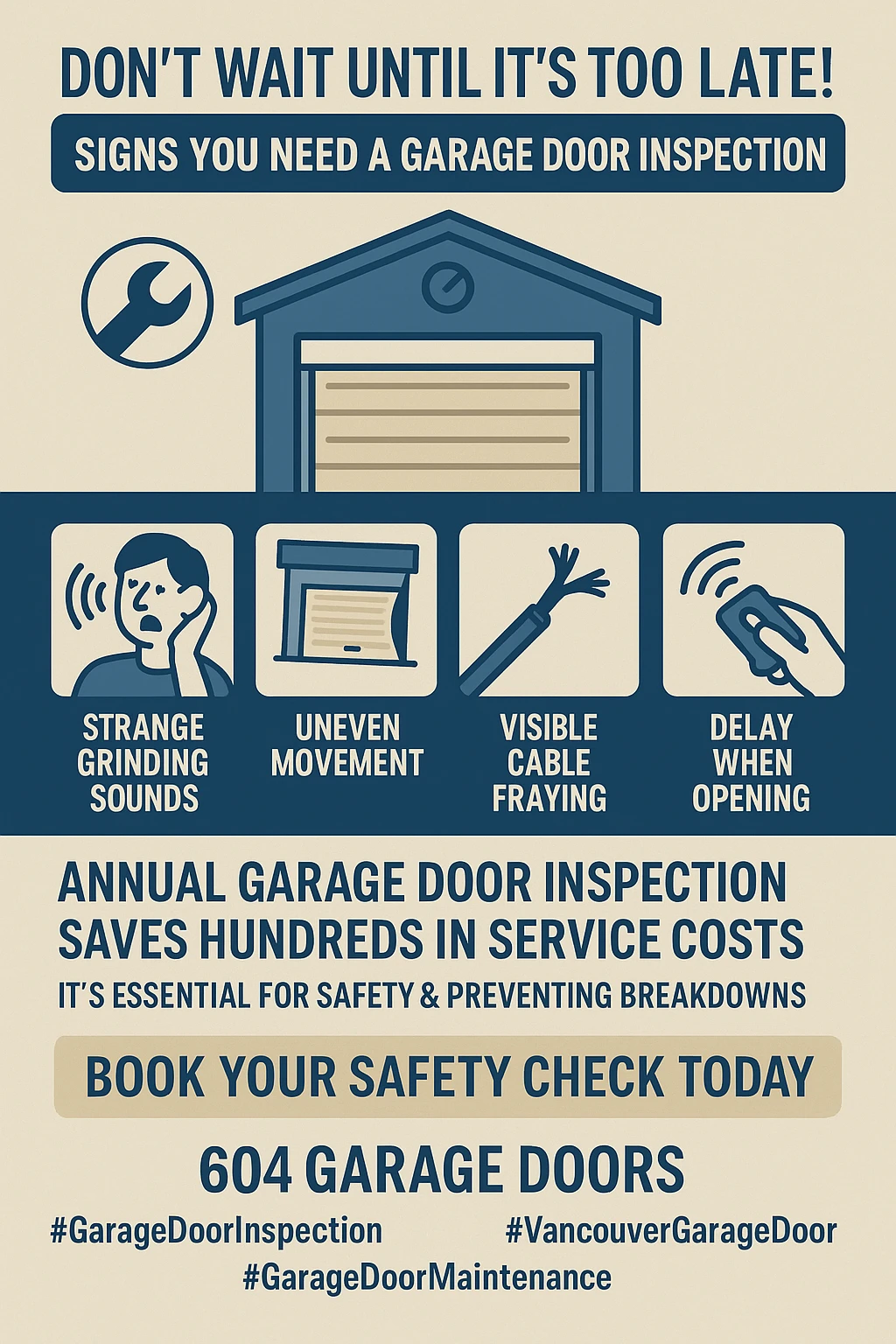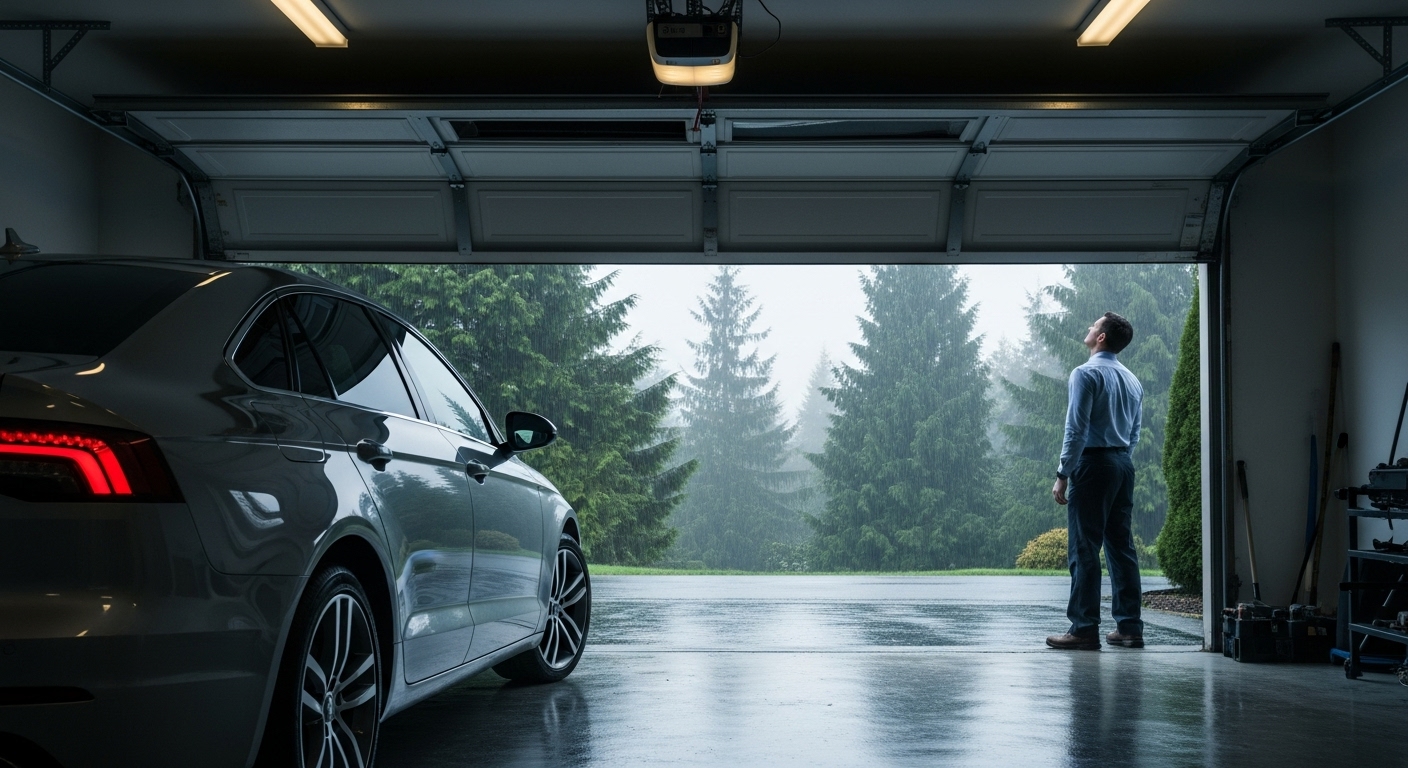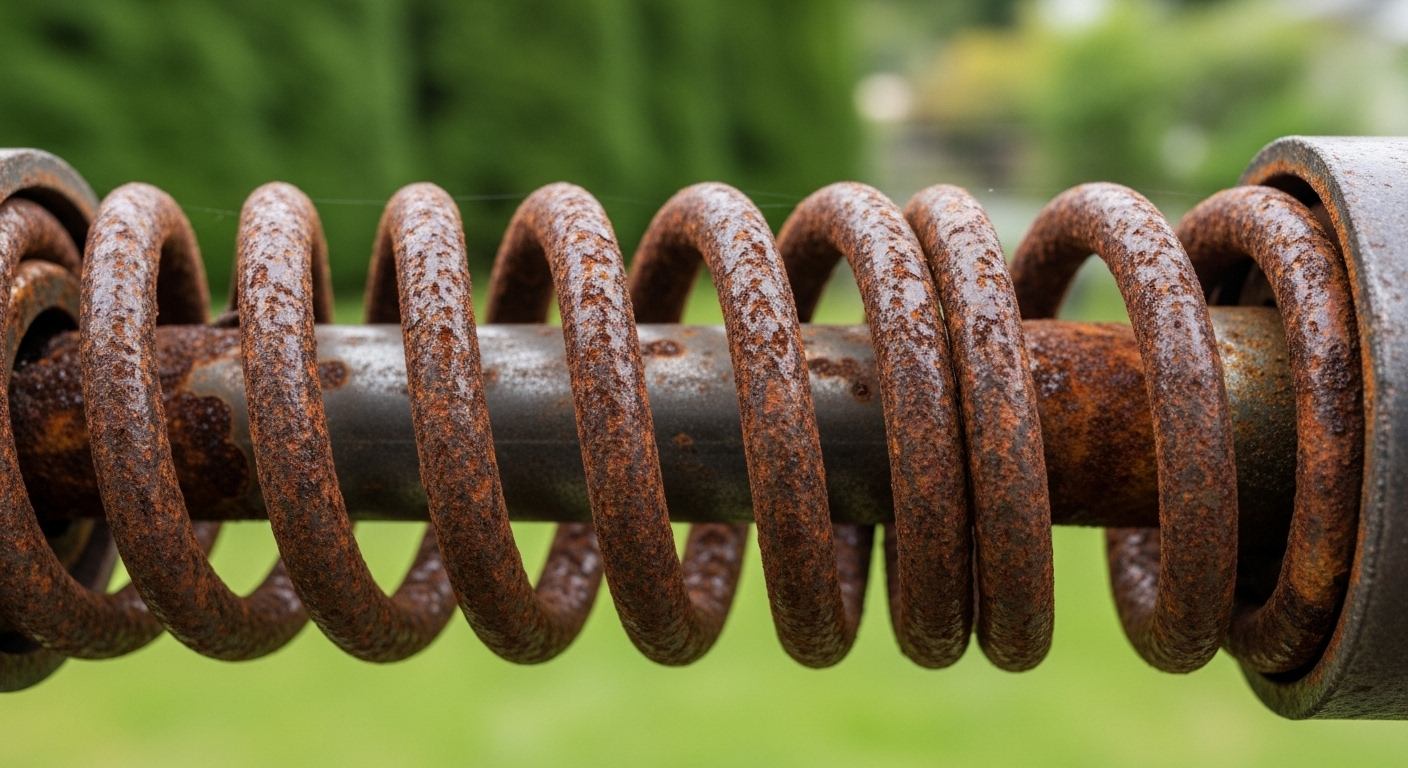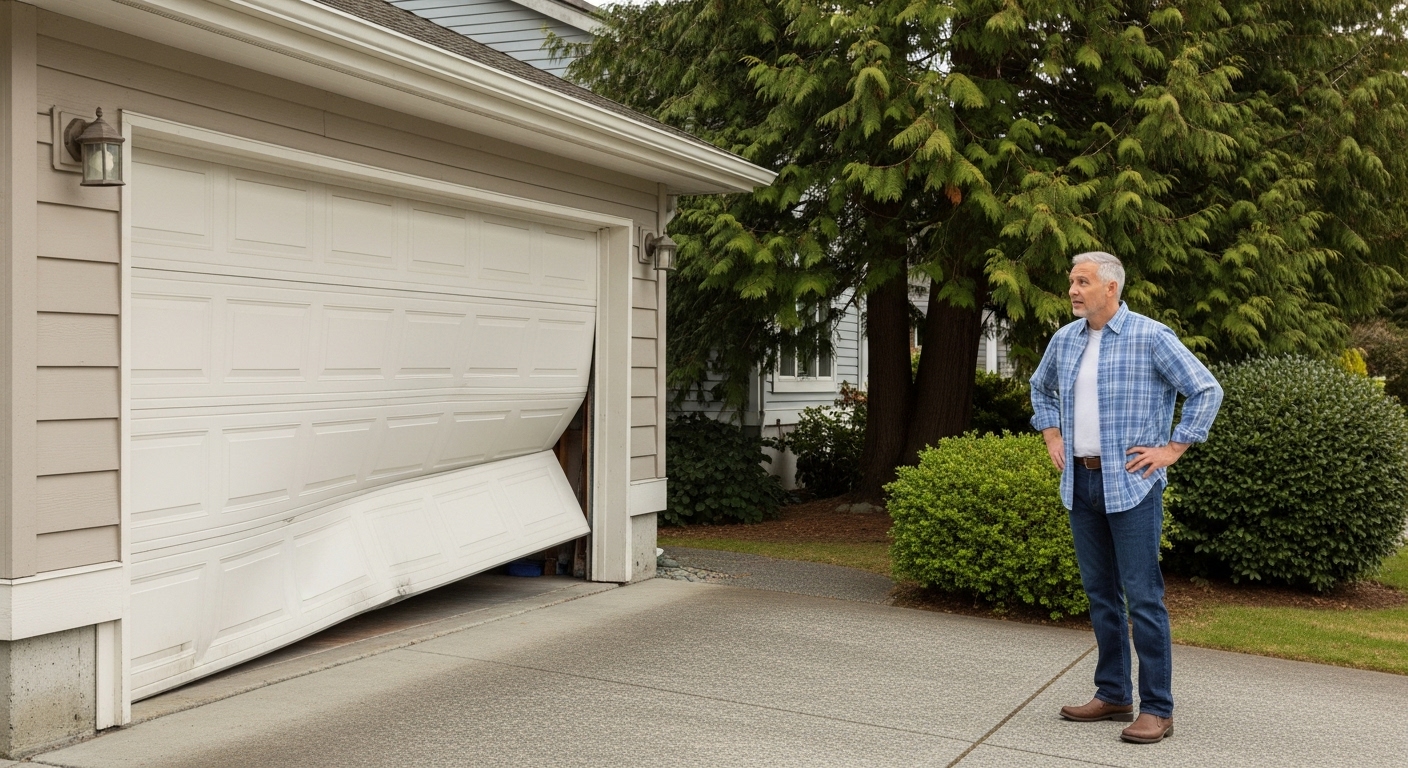Hidden Signs Your Vancouver Garage Door Needs Professional Inspection: What Most Homeowners Miss Until It’s Too Late
Hearing strange grinding noises from your garage door but brushing them off as “normal wear”? Vancouver’s coastal climate creates unique challenges for garage doors that most homeowners completely overlook until they’re faced with costly emergency repairs or complete system failures.
Picture this: You’re rushing to work on a rainy Vancouver morning when your garage door suddenly stops halfway up, trapping your car inside. [IMAGE PLACEHOLDER FOR IMAGE1] The subtle warning signs were there for months – that slightly louder whirring sound, the door hesitating for an extra second before opening, the way it felt just a bit heavier when you lifted it manually during the power outage last winter. But like most Vancouver homeowners, you missed these red flags until disaster struck.
Living in Vancouver means dealing with unique environmental challenges that accelerate garage door wear and tear. The coastal humidity, salt air from English Bay, and dramatic temperature swings between seasons create a perfect storm for mechanical failures. Yet most homeowners treat their garage doors like they live in Arizona – assuming annual maintenance is sufficient and ignoring the subtle signs that spell trouble ahead.
The reality is that Vancouver’s climate demands more attention to garage door health than most regions. Professional technicians report seeing preventable failures daily, from rusted springs in Kitsilano homes to corroded tracks in North Shore properties. The common thread? Homeowners who thought they were saving money by skipping professional inspections until that “small issue” became a major repair bill.
Key Outtakes:
- Professional garage door inspections should occur at least annually, with twice-yearly checks recommended for Vancouver’s coastal climate conditions
- Unusual noises, slow operation, and unbalanced doors are early warning signs that most homeowners ignore until major failures occur
- Vancouver’s humidity, salt air, and temperature fluctuations cause accelerated wear requiring more frequent professional assessments than inland areas
- Annual professional inspections cost $80-$150 but prevent costly repairs that can reach thousands of dollars
- Many garage door warranties require documented professional inspections to remain valid, making them essential for coverage

Vancouver’s Climate Creates Hidden Garage Door Challenges

Living on the coast comes with perks – stunning mountain views, mild winters, and fresh ocean air. But that same coastal environment wreaks havoc on garage door systems in ways that catch most homeowners completely off guard. Vancouver’s unique microclimate creates a triple threat that accelerates wear and tear beyond what you’d experience in Calgary or Regina.
The humidity levels in Vancouver consistently hover higher than inland cities, creating an environment where metal components start showing rust and corrosion within months instead of years. This isn’t the surface rust you might notice – it’s the internal corrosion that weakens springs, cables, and hinges from the inside out. [IMAGE PLACEHOLDER FOR IMAGE2] Professional technicians report that springs in Vancouver homes fail 30-40% more frequently than in drier climates, often without obvious external warning signs.
Salt air from the Pacific Ocean doesn’t just affect homes right on the waterfront. Wind patterns carry microscopic salt particles throughout the Lower Mainland, settling on garage door tracks, rollers, and hardware. This creates an electrochemical reaction that accelerates metal degradation, particularly in areas like Kitsilano, West Vancouver, and Richmond where ocean proximity intensifies the effect. The salt doesn’t just cause visible corrosion – it creates microscopic pitting that leads to sudden component failures.
Temperature fluctuations present another challenge that most homeowners underestimate. Vancouver’s weather patterns can swing from near-freezing to mild within hours, causing metal components to expand and contract repeatedly. This thermal cycling puts stress on springs, warps tracks slightly, and affects the precise alignment that garage doors require. The result? Doors that gradually become harder to operate, make unusual noises, and eventually fail when the cumulative stress becomes too much.
The combination of these factors means that garage doors in Vancouver need more frequent professional attention than most manufacturer guidelines suggest. While a door in Phoenix might operate smoothly for years with minimal maintenance, Vancouver doors face environmental stresses that accelerate wear patterns significantly. Understanding these regional factors helps explain why professional inspections become crucial for preventing major failures.
Warning Signs Most Vancouver Homeowners Miss

Walking past your garage door daily makes it easy to miss gradual changes that signal impending problems. These subtle shifts happen so slowly that your brain adapts, normalizing sounds and behaviors that should trigger immediate concern. [IMAGE PLACEHOLDER FOR IMAGE3] Professional technicians have a trained eye and ear for these early warning signs, but homeowners can learn to recognize them too.
The most commonly missed warning sign involves noise changes that develop gradually over weeks or months. That slight grinding sound when the door reaches the halfway point? It’s not “settling” – it’s likely indicating worn rollers or misaligned tracks. The gentle squeaking that starts only on humid mornings but eventually becomes constant? Your hinges and pivot points need lubrication, but more concerning, they might be developing wear patterns that will lead to failure. Professional inspectors use decibel meters and frequency analysis to detect these changes objectively, while homeowners rely on subjective memory that often fails them.
Response time delays present another frequently overlooked red flag that signals multiple potential problems. When you press your remote and the door hesitates for an extra second or two before responding, most homeowners assume it’s a battery issue or interference from neighboring remotes. In reality, delayed response often indicates problems with the opener’s circuit board, motor brushes wearing out, or safety sensors that are beginning to malfunction. These delays typically worsen gradually until the door stops responding entirely, often at the most inconvenient times.
Manual operation changes tell a story that most homeowners never think to monitor. During power outages or when testing your emergency release, does the door feel heavier than it used to? Can you still lift it smoothly with one hand, or does it require more effort? Properly balanced garage doors should operate with minimal force – if manual operation becomes noticeably more difficult, your springs are losing tension. This happens gradually enough that homeowners adapt their lifting technique without realizing the door’s weight distribution has changed dangerously.
Energy efficiency impacts often go unnoticed until utility bills spike unexpectedly. Garage doors with failing weatherstripping, compromised insulation, or gaps developing around the frame allow conditioned air to escape and outside air to enter. In Vancouver’s climate, this means your heating system works harder during winter months and cooling systems strain during summer heat waves. Most homeowners attribute higher energy bills to rate increases or aging HVAC systems, never considering that their garage door might be the culprit.
Uneven movement patterns represent perhaps the most dangerous warning sign that homeowners consistently miss. Doors that start moving at slightly different speeds on each side, create small jerking motions, or seem to “catch” momentarily during operation indicate serious structural problems developing. These patterns suggest cable tension imbalances, track alignment issues, or spring failures that can lead to complete door collapse. Recognizing these movement changes early prevents catastrophic failures that can damage vehicles, property, or cause serious injury.
Professional Expertise vs DIY Limitations

Most Vancouver homeowners take pride in handling maintenance tasks themselves, but garage door systems present unique challenges that go far beyond typical DIY capabilities. The combination of high-tension springs, electrical components, and precisely calibrated mechanical systems creates safety risks and technical complexities that require professional expertise to address properly.
Spring tension assessment represents the most critical area where professional knowledge becomes essential. Garage door springs operate under tremendous pressure – torsion springs can store enough energy to lift 300+ pound doors effortlessly, while extension springs stretch under forces that can cause serious injury if released improperly. Homeowners looking at springs visually cannot determine tension levels, wear patterns, or remaining lifespan accurately. Professional technicians use specialized tools to measure spring cycles, assess metal fatigue, and predict failure points before springs break suddenly and catastrophically.
Electrical system diagnostics require knowledge that extends far beyond basic home electrical work. Modern garage door openers incorporate safety features, limit switches, and sensor systems that interact in complex ways. When problems develop, troubleshooting requires understanding circuit logic, motor specifications, and safety compliance requirements. Homeowners attempting DIY electrical repairs often create additional problems or compromise safety systems designed to prevent injury. Professional technicians carry diagnostic equipment that can test motor performance, measure current draw, and verify safety feature functionality objectively.
Track alignment precision demands accuracy that human eyes cannot achieve reliably. Tracks that appear straight and properly aligned to homeowners might be off by fractions of inches – enough to cause increased wear, operational noise, and eventual component failure. Professional inspectors use laser levels, precision measuring tools, and alignment gauges to detect deviations that will cause problems months before they become obvious. This level of precision explains why professional installations last longer and operate more smoothly than DIY attempts.


